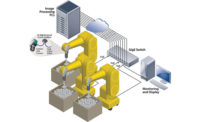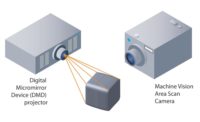
For quality inspection systems, higher bandwidth interfaces are always an attractive prospect because they allow high resolution without sacrificing frame rate in the performance of precise inspection. Further, with an increased frame rate, a system becomes more cost-effective because inspection through-put is faster.
It is not surprising then to note that some of the highest data throughput cameras on the market today are those used in quality inspection systems. Predominately based on the Camera Link protocol, these cameras provide maximum throughput rates between 4.08 Gigabits per second (Gbps) and 6.12 Gbps, depending on whether Camera Link medium or full configurations are used.
With higher bit rates becoming the norm for inspection systems, 10 Gigabit Ethernet (10 GigE) is increasingly being considered as a means to keep pace of sensor technology. However, what are the implications of using 10 GigE?

Figure 1: Shown here is a cost comparison between two systems, one with 10 GigE technology and one without. Source: Pleora Technologies
Cost: Crunching the Numbers
When considering which video interface to select for new systems, cost is a key concern for any system designer. While the bandwidth of 10 GigE is appealing, is it a reasonable contender to other video interfacing technologies?To answer this question, component pricing has been gathered to create a better understanding of a system’s overall costs. For illustration purposes, Figure 1 presents two design scenarios for a system that requires two Camera Link medium cameras and a PC that is 20 meters away from the system. In the left-hand column, the system has the two cameras connected to the PC using Camera Link; while in the right-hand column, the system employs 10 GigE technology.
The cabling and extenders required in a Camera Link system represent a substantial proportion of overall interface costs. However, these same costs can be averted by taking advantage of the greater bandwidth afforded by 10 GigE and the flexibility of the actual Ethernet cabling.
Further, the additional labor required for the cabling and extenders with Camera Link would add to costs. Therefore, although it might be a natural leap of logic to assume that 10 GigE represents a significant cost increase, crunching the numbers tells a different story: 10 GigE stands as a reasonably priced option.
Further, the exponential market growth for 10 GigE technology indicates that it will only become more and more cost-effective as time goes on. The price per port continues to drop over time from its original introductory price. In 2006, the price per port of 10 GigE technology began to drop rapidly and every indication suggests that this trend will continue, as witnessed with 1 GigE and 100 megabits per second (Mbps).
In fact, it is forecast that 10 GigE technology will likely be cost comparable with 1 GigE by the middle of this decade. Naturally, as cross-industry adoption of 10 GigE grows, costs will continue to decline, demand will accelerate and innovators will invest in further refining 10 GigE technology.

Figure 2: 10 GigE technology continues to drop in cost due to cross-industry adoption. Source: Pleora Technologies
Cabling: A Look at Practicalities
Cabling distance can either limit or broaden a system’s design options. As noted earlier, the high bit rate applications required in quality inspection systems lend themselves to medium or full Camera Link configurations. This means that each camera requires two Camera Link cables to carry data, and these cables are limited to 10 meters in length.Any routing distance between cameras and processor that must exceed 10 meters requires Camera Link repeaters or extenders. These repeaters and extenders represent an extra cost in both materials and labor, but perhaps more importantly, they increase the cabling complexity and reduce reliability.
At the processing end of the system, the required Camera Link-specific frame grabbers and the length limitations of Camera Link cables often require processing hardware to be located near the inspection machine. A more desirable design would enable the computers to be housed in a separate cabinet or room, away from dangerous or harsh manufacturing environments-yet this is not generally feasible given the cabling limitations described.
The capacity to combine the video streams, as is possible with 10 GigE, eliminates these types of nagging challenges related to cabling distance. For instance, Camera Link cables can be shortened to the distance between camera and converter, while a single copper or fiber connection carries the video data of up to four cables-two Camera Link medium/full, or 4 Camera Link base cameras-to processors located in a protective cabinet or other room.
Fiber is extremely flexible and easy to route and can be literally run for kilometers, opening up exciting new design possibilities. But further, 10 GigE technology can be used to dramatically transform how the design of these systems is approached because rather than trying to design a PC into the system, a compact 10 GigE IP engine device can be used. Once 10 GigE cameras become widely available, the converter device can be removed from the system design.

Figure 3: With 10 GigE technologies, system designers no longer need to embed a PC into their system. Source: Pleora Technologies
Next Generation Innovations
Of the market’s available video interfaces, 10 GigE is the only one to enable high value, next generation innovations, such as distributed inspection systems, made possible through networked video. This capacity lengthens the life span of a system, and therefore increases the operator’s return on investment-a key value proposition.System cost and complexity can be reduced via networking video since it reduces the hardware required per camera. It also broadens design and implementation options: designers can take advantage of different topologies, including traditional point-to-point, and topologies such as point-to-multipoint and multipoint-to-multipoint video connectivity options over 10 GigE to allow more efficient image processing.
By distributing video over a 10 GigE network, designers can create distributed inspection systems. A distributed system allows each camera to send images to a bank of PCs, with each PC searching for a specific defect. This dramatically increases inspection speed and provides exceptional new value to manufacturers seeking to increase competitive advantage.
Additionally, the introduction of new inspection algorithms is greatly simplified. In this scenario, a second bank of PCs could be trained by providing real-time image data from the cameras, all while not interrupting the in-service system (bank of PCs).





